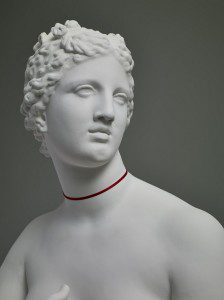ART CITIES:London-Ian Hamilton Finlay
 Ian Hamilton Finlay, was an artist, poet and “avant gardener” whose work defined and resisted the deracination of European culture; at “Little Sparta”, his home in the Pentlands, he created an extraordinary garden which fused classical and postmodern motifs, drawing especially from his heroes Vergil and the French revolutionary Saint-Just.
Ian Hamilton Finlay, was an artist, poet and “avant gardener” whose work defined and resisted the deracination of European culture; at “Little Sparta”, his home in the Pentlands, he created an extraordinary garden which fused classical and postmodern motifs, drawing especially from his heroes Vergil and the French revolutionary Saint-Just.
By Dimitris Lempesis
Photo: Victoria Miro Gallery Archive

This exhibition entitled “1789-1794”, features works that Finlay created in response to the French Revolution, and marks the first time an exhibition in the UK has focussed solely on this body of work. The French Revolution proved a rich subject for Finlay, he first received international attention for his guillotine installation “A View to the Temple” at Documenta 8 in Kassel and thereafter the guillotine became one of the most enduring elements of his iconography. For the artist the Revolution represented a moment of enormous political and aesthetic rupture and signalled a great moral, as well as political, leap. The period bookended by the dates in the title of this exhibition correspond with the establishment of the National Assembly and the storming of the Bastille in 1789, and the Thermidorian coup d’état on 27 July 1794, which saw the arrest and execution of twenty one of the key members of the Jacobin forces, including Maximilien Robespierre, Louis Antoine de Saint-Just and Georges Couthon, executed on 28/7/1894. This period thus encompasses extraordinary advances in secular democracy and social progress and also great bloodshed and unrest: the Enlightenment and the guillotine. “Aphrodite of the Terror”, is a plaster sculpture based on the Greek goddess of love and beauty known as the Medici Venus. In Finlay’s version she is adorned around the neck with a red string. The string is a reference to the thin red silk chokers worn by women whose loved ones had been executed during the Terror. The wall painting “Apollo and Daphne, After Bernini”, is based on the sculpture by Gian Lorenzo Bernini and stands as a comment on the French Revolution, in which, arguably, the revolutionary pursued ideals to the point of destruction. Finlay’s appropriation and re-interpretation of this mythological allegory highlights the contemporary resonance of classical subjects and forms.
Info: “1789-1794”, Curating: Pia Maria Simig, Victoria Miro Gallery, 16 Wharf Road, London, Duration: 10/6-31/7/15, Days & Hours: Tue-Sat: 10:00-18:00, www.victoria-miro.com


